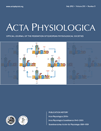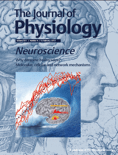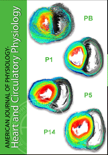
EXPERIMENTAL PHYSIOLOGY
Scope & Guideline
Integrating experimental insights for healthier futures.
Introduction
Aims and Scopes
- Physiological Mechanisms in Health and Disease:
Research focusing on the mechanisms that govern physiological processes in various systems (e.g., cardiovascular, muscular, respiratory) and how these mechanisms are altered in disease states. - Exercise Physiology and Performance:
Exploration of the physiological responses to different types of exercise, including resistance training, endurance activities, and high-intensity interval training, and their impact on athletic performance and health. - Environmental Physiology:
Studies examining how environmental factors such as altitude, temperature, and hypoxia influence physiological responses and adaptations in humans and animal models. - Neurophysiology and Muscle Function:
Research on the neural control of muscle function, including motor unit behavior, sensory feedback, and the effects of fatigue and training on neuromuscular performance. - Metabolic Responses to Nutrition and Exercise:
Investigations into how dietary components and exercise influence metabolism, including studies on energy expenditure, substrate utilization, and metabolic disorders. - Translational Research:
Studies that bridge laboratory findings with clinical applications, focusing on therapeutic interventions and the physiological underpinnings of diseases.
Trending and Emerging
- Integrative Physiology and Systems Biology:
Research that combines multiple physiological systems and employs systems biology approaches to understand complex interactions and responses is on the rise. - Impact of COVID-19 on Physiology:
Studies exploring the physiological consequences of COVID-19, including long-term effects on cardiovascular, respiratory, and metabolic health, have gained significant attention. - Gut Microbiota and Physiology:
An increasing focus on the relationship between gut microbiota and various physiological processes, including metabolism, immune function, and mental health, reflects a growing interest in microbiome research. - Heat Acclimatization and Thermoregulation:
Research examining physiological adaptations to heat exposure and acclimatization strategies, particularly in the context of climate change and athletic performance, is becoming more prominent. - Neurophysiological Mechanisms of Pain and Fatigue:
A trend towards understanding the neurophysiological underpinnings of pain and fatigue, particularly in relation to exercise and rehabilitation, is emerging as a critical area of research. - Personalized and Precision Exercise Physiology:
A growing interest in tailoring exercise prescriptions based on individual physiological responses and genetic factors is evident, reflecting a shift towards personalized medicine in exercise science.
Declining or Waning
- Traditional Cardiovascular Physiological Studies:
Research focusing solely on basic cardiovascular functions without integrating modern techniques or interdisciplinary approaches appears to be less prevalent. - Animal Models in Isolation:
While animal models remain important, there is a noticeable decline in studies that do not translate findings to human physiology or clinical contexts, as the field moves towards more translational research. - Basic Endocrine Studies:
Research focusing solely on hormonal functions without considering their interactions with physical activity or environmental factors is becoming less common as integrative approaches gain favor. - Static Exercise Studies:
Investigations that focus on static or isometric exercises without considering dynamic or functional movement patterns are less frequently published as the field emphasizes more ecologically valid assessments.
Similar Journals

Acta Physiologica
Unveiling the Wonders of Human PhysiologyActa Physiologica is a premier, peer-reviewed journal published by WILEY, dedicated to the dissemination of high-quality research across the field of physiology. With an impressive impact factor reflective of its Q1 category ranking in Physiology for 2023, this journal is a vital resource for researchers, professionals, and students alike, seeking to explore the complexities of biological systems. The journal is indexed with a commendable Scopus rank of #18 out of 193 in its category, placing it within the top 10% of its field, which underscores its influence and citation frequency within the academic community. Acta Physiologica publishes a variety of articles that address fundamental physiological concepts, innovative methodologies, and cross-disciplinary research. With its open access options, the journal ensures that cutting-edge knowledge is readily accessible, fostering an environment of collaboration and advancement in the study of physiology. Spanning from 2006 to 2024, the journal continues to be at the forefront of physiological research and education, encouraging the global sharing of knowledge through its comprehensive content.

PHYSIOLOGICAL AND BIOCHEMICAL ZOOLOGY
Illuminating the Interplay of Life's Biological SystemsPhysiological and Biochemical Zoology is a distinguished peer-reviewed journal published by University of Chicago Press, focusing on the interrelated fields of animal physiology, biochemistry, and zoology. With a strong commitment to advancing scientific understanding, this journal serves as a vital resource for researchers, professionals, and students alike, providing a platform for the latest findings and advancements in the field. Ranking in the top quartile (Q1) in Animal Science and Zoology as of 2023, and showcasing a substantial convergence of historical data from 1999 to 2023, its impact in the academic community is underscored by its engagement with high-quality research. While it also appears in the third quartile for Biochemistry and Physiology, the journal successfully integrates these disciplines, reflecting the complexity of biological systems. Available for reading via various access options, this journal is essential for anyone seeking to deepen their knowledge or contribute to the field of Zoological sciences.

JOURNAL OF PHYSIOLOGY-LONDON
Exploring the Depths of Physiology and Sports ScienceJOURNAL OF PHYSIOLOGY-LONDON, published by WILEY, stands as a prestigious beacon in the fields of Physiology and Sports Science. Established in 1878, this journal has a rich history of disseminating crucial research findings and advancing scientific knowledge, continuing its impact into the present day with an anticipated convergence in 2024. Recognized for its excellence, it ranks in the Q1 category for both Physiology and Sports Science in 2023, cementing its position within the top echelons of academic publications. With a Scopus rank of #26 out of 193 in the Biochemistry, Genetics and Molecular Biology _ Physiology category, the journal boasts an impressive 86th percentile, reflecting its high-quality contributions to the scientific community. Although not open access, its extensive archive and reputation ensure that it remains a vital resource for researchers, professionals, and students eager to stay at the forefront of physiological science. For those looking to deepen their understanding of physiological mechanisms and their applications, the JOURNAL OF PHYSIOLOGY-LONDON is an indispensable resource.

Journal of Physiological Sciences
Pioneering Research for a Healthier TomorrowThe Journal of Physiological Sciences, published by BMC, stands as a prominent platform for the advancement of research in the field of physiology. Based in Japan, this open-access journal (ISSN: 1880-6546, E-ISSN: 1880-6562) is committed to disseminating high-quality scientific articles that explore various facets of physiological functions and mechanisms. With a 2023 Scopus ranking placing it within the 41st percentile in the category of Physiology, it is recognized for contributing significant insights that bridge basic and applied physiological research. The journal maintains a Q2 quartile ranking within its category, highlighting its impact within the scientific community. Researchers, professionals, and students are encouraged to engage with cutting-edge studies published from 2006 to 2024, fostering an environment of knowledge accessibility and scientific collaboration. The journal not only serves as a vital resource for those involved in physiological research but also promotes broader understanding and application of physiological principles across various health and science sectors.

Physiological Genomics
Bridging Genetics and Physiology for a Healthier FuturePhysiological Genomics is a prestigious scholarly journal published by the American Physiological Society, dedicated to advancing the understanding of the genetic underpinnings in physiology. With an ISSN of 1094-8341 and an E-ISSN of 1531-2267, this journal serves as a vital platform for researchers exploring the intersection of genetics and physiological processes. As of 2023, it enjoys a respectable impact factor, particularly standing strong in the Q2 quartile in both Genetics and Physiology categories, illustrating its importance within a competitive landscape. With an impressive rank of #69 out of 193 in Biochemistry, Genetics, and Molecular Biology - Physiology, and #128 out of 347 in Genetics, it reflects a robust commitment to quality research. Committed to fostering innovation, Physiological Genomics provides comprehensive access to groundbreaking studies from 1999 to 2024 and remains a quintessential resource for researchers, professionals, and students alike aiming to enhance their understanding of physiological genomics.

Applied Physiology Nutrition and Metabolism
Empowering Research in Physiology and NutritionApplied Physiology, Nutrition, and Metabolism is a renowned journal published by Canadian Science Publishing, focusing on the interdisciplinary fields of physiology, nutrition, and metabolic science. Since its inception in 2006, this journal has established itself as a leading source of cutting-edge research, providing a platform for innovative studies that impact clinical practices, fitness, and health guidelines. With an impressive recognition within the academic community, it boasts a Q1 rank in Nutrition and Dietetics and Q2 ranks in Endocrinology, Diabetes and Metabolism, and Physiology categories in 2023, highlighting its significance in advancing knowledge in these critical areas. The journal offers open access options, promoting broader dissemination of research findings to enhance global health outcomes. Situated in Canada, Applied Physiology, Nutrition, and Metabolism aims to integrate science and practical applications, making it essential reading for researchers, clinicians, and students dedicated to exploring the dynamic interactions between nutrition, physical activity, and metabolic health.

AMERICAN JOURNAL OF PHYSIOLOGY-ENDOCRINOLOGY AND METABOLISM
Unveiling the complexities of hormonal and metabolic processes.American Journal of Physiology-Endocrinology and Metabolism, published by the American Physiological Society, stands as a leading platform for disseminating high-quality research in the fields of endocrinology, diabetes, and metabolism, as well as general physiology. With an impressive impact factor placing it within the Q1 category across multiple relevant disciplines (Endocrinology, Diabetes and Metabolism; Physiology; and Medical Physiology), this journal reflects its authoritative position in the scientific community. Spanning from 1980 to 2024, the journal consistently publishes groundbreaking studies and significant findings that advance our understanding of hormonal regulation and metabolic processes. Although it does not currently offer open access, it provides valuable resources for researchers, professionals, and students alike, eager to stay at the forefront of advancements in physiological sciences. Addressed in Rockville, Maryland, its commitment to excellence and rigorous peer review ensures that every article contributes essential insights to the field.

PFLUGERS ARCHIV-EUROPEAN JOURNAL OF PHYSIOLOGY
Showcasing Excellence in Physiological StudiesPflügers Archiv - European Journal of Physiology, published by Springer Heidelberg, stands at the forefront of physiological research, showcasing groundbreaking studies since its inception in the 1950s. With a distinguished ISSN of 0031-6768 and an E-ISSN of 1432-2013, this esteemed journal maintains a robust reputation, holding Q1 rankings in Clinical Biochemistry, Physiology, and Medical Physiology as of 2023. Its impressive Scopus rankings place it in the top percentile across various categories, including Biochemistry, Genetics and Molecular Biology and Medicine. Pflügers Archiv serves as a vital platform for researchers, professionals, and students, facilitating the dissemination and discussion of advanced physiological concepts and methodologies. Although it does not currently offer open access, its rigorous peer-review process ensures the highest quality publications that contribute significantly to our understanding of physiological science. Explore the depth of physiological research that shapes our academic landscape today.

INTERNATIONAL JOURNAL OF SPORT NUTRITION AND EXERCISE METABOLISM
Elevating Performance through Science and NutritionINTERNATIONAL JOURNAL OF SPORT NUTRITION AND EXERCISE METABOLISM, published by Human Kinetics, is a leading academic journal dedicated to the interdisciplinary fields of sports nutrition and exercise metabolism. With ISSN 1526-484X and E-ISSN 1543-2742, the journal provides a critical platform for researchers and practitioners to explore the intricate relationships between nutritional strategies, exercise physiology, and performance outcomes. Boasting a commendable impact factor and ranking in the Q2 category across multiple disciplines, including Medicine (miscellaneous), Nutrition and Dietetics, Orthopedics and Sports Medicine, and Sports Science, the journal is recognized for its contribution to advancing knowledge in these vital areas. Researchers are encouraged to submit their findings and engage with cutting-edge studies spanning from 1996 to the present. While the journal currently does not offer open access, its reputation as a peer-reviewed resource ensures high-quality evidence for both academic study and practical application. For those invested in optimizing athletic performance through nutritional insights, INTERNATIONAL JOURNAL OF SPORT NUTRITION AND EXERCISE METABOLISM is an invaluable resource.

AMERICAN JOURNAL OF PHYSIOLOGY-HEART AND CIRCULATORY PHYSIOLOGY
Unveiling the complexities of heart physiology.AMERICAN JOURNAL OF PHYSIOLOGY-HEART AND CIRCULATORY PHYSIOLOGY, published by the American Physiological Society, is a premier journal dedicated to advancing the understanding of cardiovascular physiology. With an ISSN of 0363-6135 and an E-ISSN of 1522-1539, this esteemed journal has been a vital resource since its inception in 1977, and continues to publish cutting-edge research that shapes the fields of cardiology and physiology. Recognized as a Q1 journal in multiple categories, it ranks impressively within the top tier of its fields, including a notable 18th percentile rank in Physiology (medical). The journal’s impact factor and extensive reach in the academic community affirm its significance in promoting innovative studies and insights. While it does not offer open access options, the journal remains accessible through institutional subscriptions, making it an essential tool for researchers, professionals, and students alike, who are keen to stay abreast of the latest developments in heart and circulatory physiology. For further information, the journal is based in the United States at 6120 Executive Blvd, Suite 600, Rockville, MD 20852. As a cornerstone of cardiovascular research, it invites contributions that push the boundaries of knowledge and enhance clinical practice.